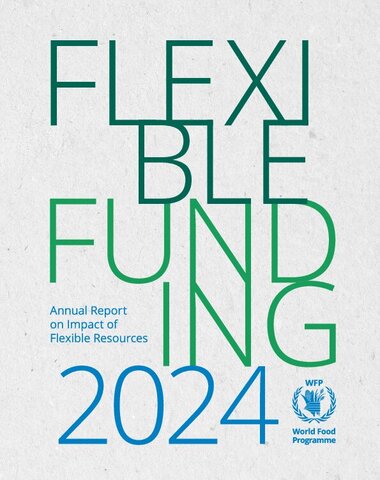
Flexible Funding: Empowering WFP to deliver faster, smarter, and at greater scale
In 2024, as global humanitarian needs continued to rise, flexible funding played a vital role in enabling the World Food Programme (WFP) to respond swiftly and strategically. While much of WFP’s work depends on earmarked contributions designated for specific countries, operations or thematic programmes, US$1.1 billion in flexible support from 38 public and private partners provided critical agility — allowing WFP to work not only faster, but smarter.
This flexible support enabled WFP to reach people facing urgent crises and to allocate resources where they were most needed. In a year when an estimated 343 million people faced acute food insecurity, flexible funding helped WFP deliver life-saving assistance to 124 million people across 87 countries, providing critical food, nutrition, and resilience support. 80% of all flexible resources in 2024 were allocated to crisis response, and 20% to resilience building initiatives.
Key highlights of WFP’s impact made possible by flexible funding in 2024 include:
- Rapid emergency response: Flexible funding allowed WFP to act immediately in fast-evolving crises — from sudden-onset disasters to escalating conflicts — ensuring food and nutrition assistance reached those in urgent need without delay. The UN Humanitarian Aviation Service (UNHAS), supported by flexible funds, sustained 21 operations worldwide, including in hard-to-reach crisis zones like South Sudan and Niger.
- Strategic resource allocation: The ability to allocate funds where needs were most acute maximized the reach and efficiency of WFP operations, ensuring that limited resources had the greatest possible impact.
- Strengthening resilience: In addition to emergency assistance, flexible funding supported long-term programmes that help vulnerable communities build resilience to future shocks, reducing their dependence on humanitarian aid over time.
- Global reach: With the support of flexible contributions, WFP operated in 87 countries, responding to a diverse range of emergencies and development needs worldwide.
- Catastrophic conditions: Flexible funding was crucial in reaching populations facing the most extreme levels of hunger, including the 1.9 million people experiencing catastrophic (IPC Phase 5) conditions — one step away from famine.
The dedicated support of 38 partners — spanning both public and private sectors — made this life-saving work possible. Their commitment to providing flexible resources ensured that WFP could adapt, innovate, and respond effectively in a rapidly changing world, helping millions of people not only survive today but build a stronger tomorrow.
| Document | File |
|---|---|
| WFP Annual Report on Flexible Funding 2023 |
PDF | 16.4 MB
Download
|
| WFP Annual Report on Flexible Funding 2022 |
PDF | 13.87 MB
Download
|
| WFP Annual Report on Flexible Funding 2021 |
PDF | 5.47 MB
Download
|
| Use of Flexible and Immediate Response Account Funding in 2020 |
HTML | 50.63 KB
Download
|
| Use of Flexible and Immediate Response Account Funding in 2019 |
Web page
View
|
